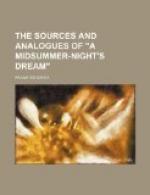Puck is strictly not a proper name; and in the quartos and folios of A Midsummer-Night’s Dream, Puck, Robin, and Robin Goodfellow are used indiscriminately. In no place in the text is he addressed as “Puck”; it is always “Robin"[34] (once[35] “Goodfellow” is added). In the last lines of the play he twice refers to himself as “an honest Puck” and “the Puck,” [36] showing that the word is originally a substantive. Dr. J.A.H. Murray has very kindly allowed the slips of the New English Dictionary which contain notes for the article ‘Puck’ to be inspected; his treatment of the word will be awaited with much interest. The earliest and most important reference is to Prof. A.S. Napier’s Old English Glosses (1900), 191, where in a list of glosses of the eleventh century to Aldhelm’s Aenigmata occurs “larbula [i. e. larvula], puca.” Prof. Napier notes that O.E. puca, “a goblin,” whence N.E. Puck, is a well authenticated word. Dr. Bradley suggests that the source might be a British word, from which the Irish puca would be borrowed; this word pooka, as well as the allied poker, has already been treated in the N.E.D. Puck, pouke, we find in O.E. (Old English Miscellany, E.E.T.S., 76), in Piers Plowman, and surviving in Spenser; but there are countless analogous forms: puckle, pixy, pisgy, in English, and perhaps (through Welsh) bug, the old word for bugbear, bogy, bogle, etc.; puki in Icelandic; pickel in German; and many more.[37]
We may note here the euphemistic tendency to call powerful spirits by propitiatory names. Just as the Greeks called the Furies “Eumenides,” the benevolent ones, so is Robin called Good-fellow; the ballad of Tam Lin[38] refers to them as “gude neighbours”; the Gaels[39] term a fairy “a woman of peace”; and Professor Child points out the same fact in relation to the neo-Greek nereids.[40] Hence also “sweet puck."[41] The names of the four attendant fairies, Peaseblossom, Cobweb, Moth, and Mustard-seed, are Shakespeare’s invention, chosen perhaps to typify grace, lightness, speed, and smallness.
The literary sources on which Shakespeare, in writing of fairies, probably drew—or those, at least, on which he could have drawn—can be shortly stated. We have already mentioned Scot’s Discovery of Witchcraft (1584); this was no doubt the chief source of information regarding Puck or Robin Goodfellow, as well as of the fairies themselves. Shakespeare was doubtless also familiar with the treatment accorded to the fairy-world by Chaucer[42] and Spenser[43] and with the many tales of supernatural beings in romances like Huon of Bordeaux and others of the Arthurian cycle. There is also a black-letter tract concerning Robin Goodfellow,[44] but no one has yet proved that this pamphlet was in print before 1628, the date of the earliest surviving edition. Ultimately, however, this matters little, because the tract is evidently drawn largely from oral traditions about Robin, and so has a source common with that of much of Shakespeare’s fairy-lore.




